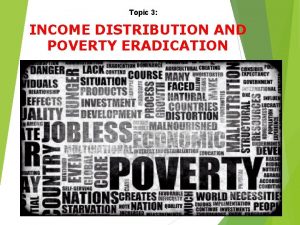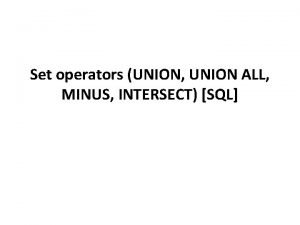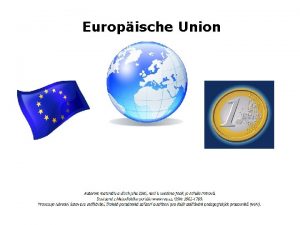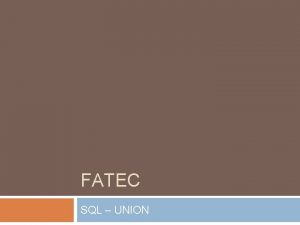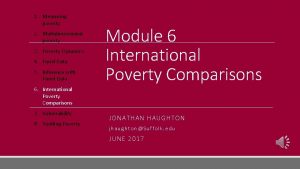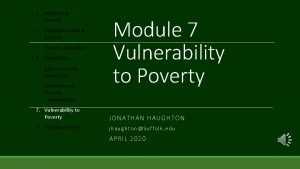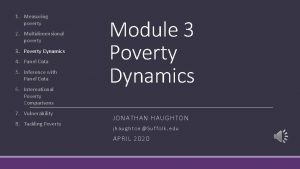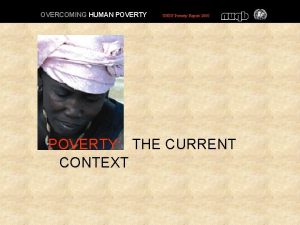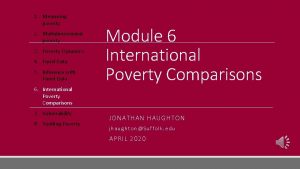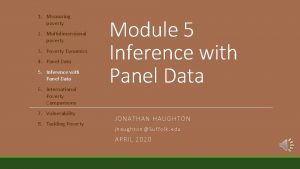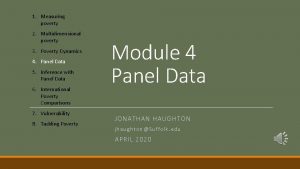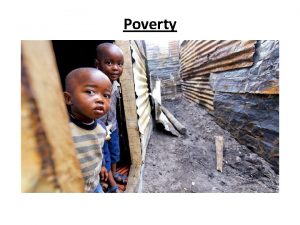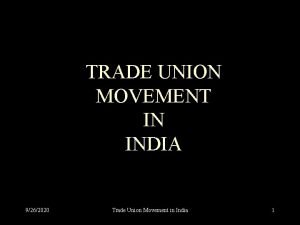Energy Poverty Energy Union Energy Poverty in the

















- Slides: 17

Energy Poverty – Energy Union Energy Poverty in the Energy Union What progress? What way forward? Sian Jones, EAPN Policy Coordinator

y Energy Poverty – State of Play Outline • Introduction • State of play on Energy Poverty • Way forward

Introducing EAPN q Independent Network of NGOs committed to fight against poverty + social exclusion, with people in poverty. q Receives financial support from the European Commission (PROGRESS/now Ea. Si) q 32 National Networks and 14 European NGOs as members (10, 000+ organisations) q Started in 1990 – key actor in poverty programmes and development of social OMC, Lisbon and Europe 2020 q Active on Energy poverty issue since 2008 – right to energy! q Participation of people with direct experience of poverty must be part of the solution.

15 th EU People Experiencing Poverty Meeting

EAPN and Energy Poverty q Energy Poverty seen as growing challenge since 2000 q 2009 –Joint EP campaign Electricity /Gas market rules q 2014 Coordinated workshop with DG Energy q 2015 active in vulnerable consumers group, EPC TF q 2016 work with Greens/EFA Tamas Meszerics linked to opinion and handbook and good practices. q 2016 Work to get energy poverty in EPSR q 2017 Joint work with EPSU -leaflet on the Right to Energy and launch of Right 2 Energy Coalition q Assist Project/Horizon 2020 (BG, IT, PL, UK, ES)

What is Energy Poverty? How many? q Energy poverty is when a person is not able to heat or fuel their home to an acceptable standard at an affordable cost q No agreed EU definition - EG Scotland 2018: Households should be able to afford the heating and electricity needed for a decent quality of life. Once a household has paid for its housing, it is in fuel poverty if it needs more than 10% of its remaining income to pay for its energy needs, and if this then leaves the household in poverty. ” Based on the UK Minimum Income Standard (MIS) poverty approach. Ø Between 50 and 125 million ml people at risk of energy poverty, 125? 1 in 10 can’t heat home. Ø 41. 5 ml arrears in paying utility bills (EU SILC 2016) and increase Ø 7 million disconnections

Energy Poverty – 3 Main Causes 1. Low Incomes and overall poverty 2. High energy consumption: poor thermal efficiency and bad housing 3. High energy costs Other important factors q Interlinkages are crucial q Personal factors eg age, disability, family situation, discrimination. .

Energy Poverty – Main Trends q Lack of comparable indicators or data Ø 11% of population at risk of energy poverty, 44 -50 million (2016) –worst: C, E and S Europe (Insight_E study) Ø EU SILC – inability to keep home warm (2008 -15) Area 2008 2012 2016 EU 28 9. 3 10. 8 8. 7 BE 6. 4 6. 6 4. 8 BG 66. 3 46. 5 39. 2 EL 15. 4 26. 1 29. 1 LT 22. 6 34. 1 29. 3 PT 34. 9 27. 0 22. 5 SE 1. 5 1. 4 2. 6

Trends on average spending on Fuel

Rising Energy Poverty – What causes? 1) Declining household incomes + increasing poverty – Ø Due to unemployment, cuts: wages, benefits, services. Ø 109 million people in poverty nearly 1 in 4 despite a poverty target. Return to 2008 figures after crisis. 2) High and Rising Costs of Fuel Ø Since 2004, fuel prices have increased by over 70% in real terms (Walker, Thomson and Liddell 2013) Ø Rises strongly connected to deregulation and privatization (S. Bouzarovski) Ø Also climate protection polices eg in Germany (200%). 3) Low energy efficiency and low quality housing Ø Strong link between bad housing, energy demand poverty – particularly for vulnerable groups Ø Energy efficiency measures passed on in higher rents/split incentives in 21 countries eg IUT (2016)

Energy Poverty – What Consequences? q Affects the most vulnerable: older people, children, disabled, minorities, single parents (80% women) q 100. 000 excess winter deaths due to cold homes and 80 million live in damp homes. q Cycle of debt Ø Utility bills are major cause of indebtedness (68%) real prices up 70% since 2004. “ We have to choose between heating and eating’ q Cut offs and evictions Ø Still lack of detailed information from regulators (ACER) Ø Increase in disconnection rates in 2014 eg 4% Italy, 2. 3% Spain, 352. 000 in Germans with 6. 3 ml threats. q Deteriorating health including mental health Ø Children living in cold homes 2 x respiratory problems. Ø Older people higher mortality, arthritis etc (Marmot) Ø 1 in 4 adolescents risk of mental health problems

What EU Policy Actions? 2009: 3 rd Energy Package: Ø Established energy poverty for the 1 st time as an EU issue. Ø “ MS shall take appropriate measures to protect final outcomes and provide adequate safeguards for vulnerable customers MS shall define vulnerable customers and may refer to energy poverty and to the prohibition of disconnection of electricity and gas at critical times. 2018 Clean Energy Package Ø 8 legislative proposals: energy efficiency, energy performance of buildings, renewal of energy etc. Ø Must outline what they are doing and can define national objectives to reduce energy poverty Ø A share of annual saving measures can target vulnerable Ø National Energy and Climate Plans but little focus on EP 2017 European Pillar of Social Rights: Ø 20) Right to essential services: energy. What impact?

New Commission – new direction? A Union that strives for more! – Political Guidelines 2019 -24 A European Green Deal – 1 st 100 days - Become climate neutral continent. - Increase emissions target to 50% - Decarbonize energy intensive industries - Just transition fund and European Climate Pact Ø Timmermans – Vice President for EGD: Hearing “ We mustn’t raise energy bills but lower them – 50 million energy poor is unacceptable”. We need large renovation projects for social housing with fair financing schemes to avoi paying money upfront’. In response to question about economic impact eg Yellow Vests “increased tax could hit people hard, must propose winwins. We are taxing the wrong things, this should have an alleviating effect on middle and low incomes. ”

What Solutions 1. Right to Energy – no disconnections! 2. EU definition of Energy Poverty 3. Ex-ante social distributional impact of Green New Deal and Just transition proposals. 4. Integrated approach linking 3 pillars, key to success of national action plans, with social stakeholders. 5. Specific pillars: Ø Support for Regulated Prices and social tariffs Ø Invest in decent affordable housing, particularly social housing Ø Invest in energy efficiency projects to benefit poor families and avoid passing on costs Ø Income poverty - minimum income/wage. 6. Participation of users/CSOs at all stages.

What way forward – people at the heart

For Further Information www. eapn. eu § R 2 Energy Coalition: righttoenergy. org § www. assist 2 gether. eu § Energy Poverty Handbook (Greens/EFA, BPIE, Housing Europe, EAPN) 2016 § Good Practices (Ibid) § EAPN Working Document on Energy Poverty (2010)

For Further Information Contact Sian Jones, EAPN Policy Coordinator E-mail: sian. jones@eapn. eu Phone: +32 2 226 5859 Address: Boulevard Bischoffscheim 11, 1000 Brussels; Website: www. eapn. eu
 Relative poverty
Relative poverty Union union all intersect
Union union all intersect Hát kết hợp bộ gõ cơ thể
Hát kết hợp bộ gõ cơ thể Frameset trong html5
Frameset trong html5 Bổ thể
Bổ thể Tỉ lệ cơ thể trẻ em
Tỉ lệ cơ thể trẻ em Gấu đi như thế nào
Gấu đi như thế nào Tư thế worm breton
Tư thế worm breton Alleluia hat len nguoi oi
Alleluia hat len nguoi oi Môn thể thao bắt đầu bằng từ đua
Môn thể thao bắt đầu bằng từ đua Thế nào là hệ số cao nhất
Thế nào là hệ số cao nhất Các châu lục và đại dương trên thế giới
Các châu lục và đại dương trên thế giới Công thức tiính động năng
Công thức tiính động năng Trời xanh đây là của chúng ta thể thơ
Trời xanh đây là của chúng ta thể thơ Cách giải mật thư tọa độ
Cách giải mật thư tọa độ Phép trừ bù
Phép trừ bù Phản ứng thế ankan
Phản ứng thế ankan Các châu lục và đại dương trên thế giới
Các châu lục và đại dương trên thế giới
